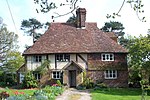LeeFest
Neverworld, formerly known as LeeFest, is a music festival that takes place each Summer in Kent, England. The festival began in founder Lee Denny's garden when his parents went away on holiday in 2006. Despite the festival's small scale in its first two years, by 2011 LeeFest grew into a two-day event with enough capacity for 2,000 people. The festival's capacity has since expanded to 5,000, moving to a new site in 2016. Around 200 volunteers help out during the festival. The festival has won two awards and been nominated for several more. Awards include: 'Best Independent Festival' at AIM Independent Music Awards, 2012 and 'Best Grass Roots Festival' at the UK Festival Awards 2009. Denny was awarded the Spirit of London Awards ‘Achievement in The Arts in December 2012. In the same year he was also placed in Time Out UK 2012: 100 Culture List in the UK's Time Out magazine, considering him "One of the inspiring 100 people in the UK who have made others lives better".
Excerpt from the Wikipedia article LeeFest (License: CC BY-SA 3.0, Authors).LeeFest
Wilderness Lane,
Geographical coordinates (GPS) Address Nearby Places Show on map
Geographical coordinates (GPS)
| Latitude | Longitude |
|---|---|
| N 51.169 ° | E 0.115 ° |
Address
Wilderness Lane
Wilderness Lane
TN8 7LP , Hever
England, United Kingdom
Open on Google Maps











